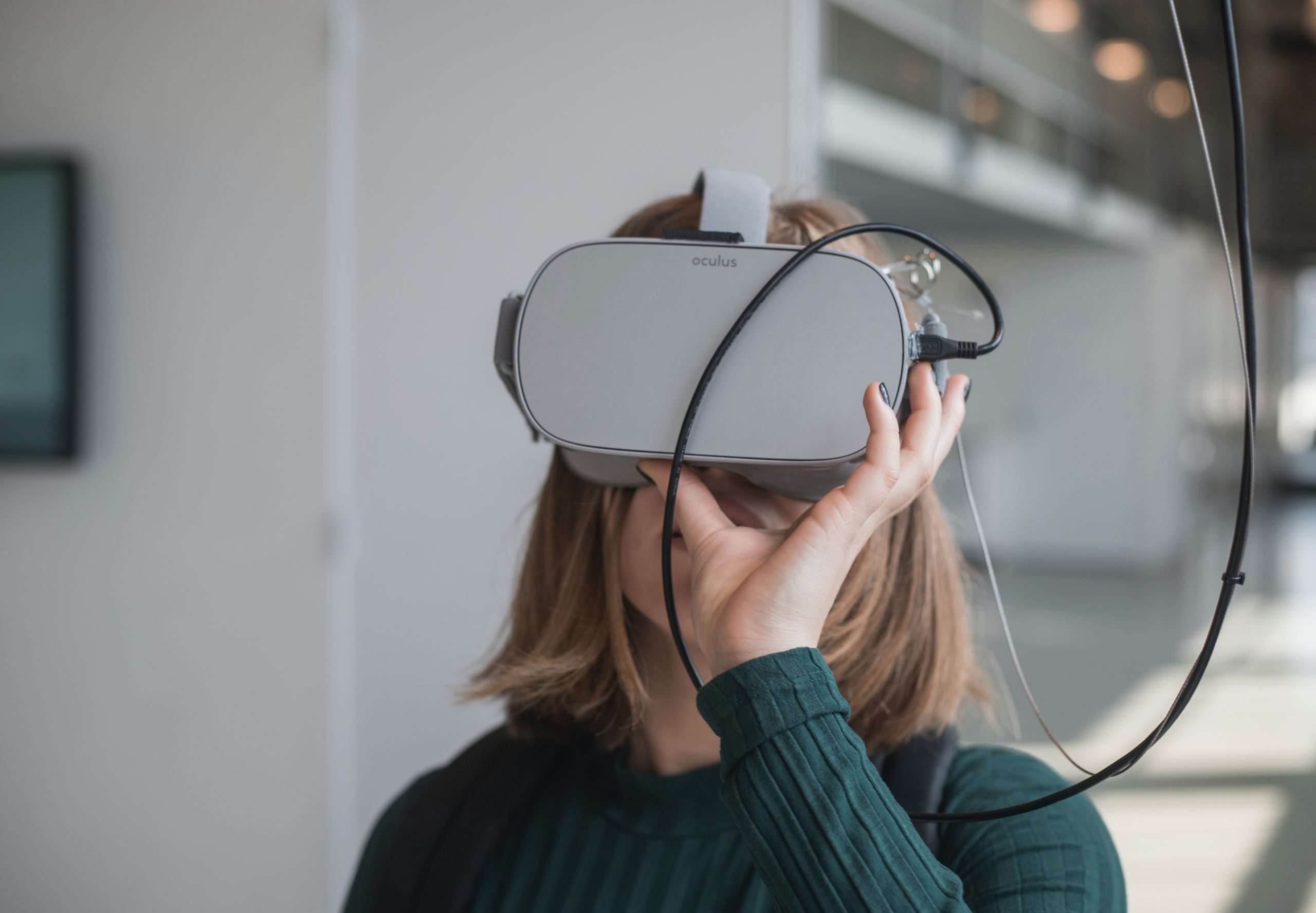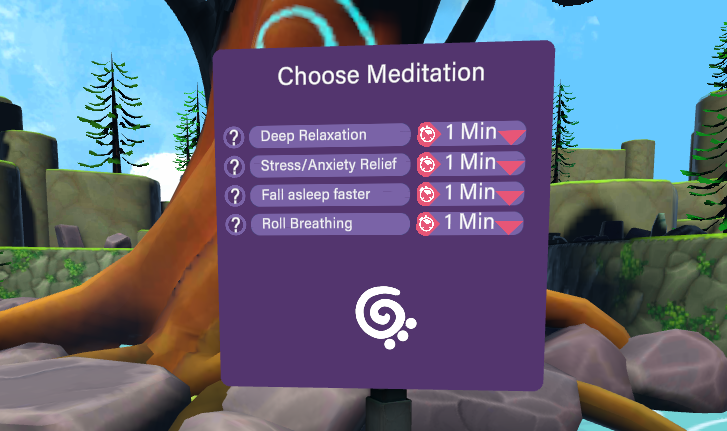Mindfulness breaks are not just for the real world
What about mindfulness and VR?
The practice of being mindful has become incredibly popular, with about 11.8 million people in the U.S. turning to a meditation practice for health reasons (Cramer et al., 2016). Mindfulness techniques include breathing exercises and guided imagery, and they aim to relax the body and the mind, and to reduce stress (Mayo Clinic, 2020). The benefits in the real world seem to be endless; a mindfulness practice can help curb stress, anxiety, physical pain, depression, insomnia, and high blood pressure. But as our lives move increasingly online, or start to include virtual reality (VR) games and experiences, how can mindfulness exercises help us find balance in the online world?
What is mindfulness exactly?
Mindfulness is a type of meditation where you focus on being intensely aware of your sensations and feelings in the moment, without interpreting or judging them (Mayo Clinic, 2020). This involves calmly acknowledging and accepting our bodily sensations, how you are feeling, and what you are thinking. You might practice mindfulness in a crowded café (which will hopefully be possible soon in a covid-19-free world). Imagine there’s a toddler at the table next to you throwing a tantrum, two friends having a lively conversation in the corner, and the clanking of cups and saucers from the bar, all on top of the loud music coming through the café’s sound system. Your mindfulness training will help you maintain your own inner peace as you simply accept what is going on in the environment around you.

Image by The Creative Exchange via Unsplash
Mindfulness has spread far and wide
The popularity of mindfulness in the West began in the 1990s, and it has continued to gain attention since by both the public as well as clinicians (Nisbet, 2017; Baer, 2017). Mindfulness programs have been implemented in workplaces, community projects and in healthcare (Spijkerman et al., 2016). Such programs have also been implemented in schools for children to learn to calm themselves down and practice breathing techniques. Professional athletes and CEOs are among those who practice mindfulness to improve their performance. Meanwhile, health professionals use the technique to treat a range of conditions including depression, anxiety, physical pain and post-traumatic stress disorder (Nisbet, 2017).
Mindfulness-based interventions (MBIs) have been found to have a small to moderate positive effect on one’s well-being (Spijkerman et al., 2016). Specifically, online MBIs, such as the popular Headspace or Calm apps, have shown the potential to increase mental well-being and, specifically, decrease stress.
What about mindfulness and VR?
There is plenty of evidence showing the benefits of mindfulness in the real world, but what about the virtual world? VR games and experiences are now readily available to consumers. If you own a VR headset, you can walk through relaxing landscapes, fight zombies, run from dinosaurs, or get in a good work out with a variety of games and apps. VR technology is not only fun, but offers a perfect training environment where learners can make mistakes without causing damage to expensive equipment. VR learning games have been used successfully for workplace training, military training, medical training and education, and is more efficient than classroom training and e-learning (Likens & Eckert, 2020). Since VR puts users in an immersive, but low-stress, environment, it increases their focus and training speed.
In the medical field, VR is being used for cognitive rehabilitation with great results in various patient populations, from children with autism (Wang & Reid, 2013), to people who have survived an acquired brain injury (ABI) (Maggio et al., 2019a; Maggio et al., 2019b). ABIs include stroke, aneurysm or tumors, as well as traumatic brain injuries (TBI) such as falls, assaults, and sports injuries. VR based cognitive rehabilitation for these patient populations helps create improved health outcomes and quality of life.

Image by Maxim Hopman via Unsplash
Mindfulness and VR Training
At NeuroReality, we are developing such an approach to tackle cognitive rehabilitation for ABI survivors. Our solution is a VR-based serious game called Koji’s Quest; it trains specific cognitive functions to help individuals improve their memory, attention, visio-spatial abilities and executive function, so they can return to their lives as quickly as possible after an ABI.
While we are excited for ABI survivors to play Koji’s Quest to boost their rehabilitation, we can’t ignore how important it is to take a break to maximize the effects of brain training and process new information. When users are ready to take a break from training, the game includes a built-in rest and meditation environment. In Koji’s Quest, the “Garden of Zen” encourages users to take a moment to clear their heads and take a breath; to be present. In each user’s personalized and peaceful garden, players can practice meditation and breathing exercises so they are ready to continue training.
Offering users this meditation break is very important. As described by NeuroReality’s patient expert and researcher, Inês Pires:
“Breathing exercises are important as they help you to relax and increase energy. By controlling your breathing, you can slow down your heart rate, bring more oxygen to the brain and increase endorphins which can help regulate your emotions. They are a valuable technique for improving overall health. By taking a few minutes every day to focus on your breathing, you are giving your body and mind an extra boost!”
A study investigating the effect of mindfulness meditation on cognition found that short-term meditative training is able to enhance your ability to sustain attention (Zeidan et al., 2010). Mindfulness training can improve your ability to focus your attention in the long-term as well (van Leeuwen et al., 2008).

Meditation in Koji’s Quest
Conclusion
Not only is mindfulness beneficial for people managing a variety of mental and physical complaints, but mindfulness trainings have also been shown to enhance cognitive abilities such as your attention span. The lighting-speed developments in VR offer a whole new world of learning and entertainment solutions. These games can be addictive and fun (we know Koji’s Quest is!), but it’s important to give your brain a break from training to increase its effectiveness. Although we’re excited that our VR-based serious game will give ABI patients a boost in their rehabilitation journeys, Koji will also remind users to take a mindfulness break to make that journey even more effective!
References
Baer, D. (2017, October 10). How mindfulness went from fringe to mainstream. Thrive Global. https://thriveglobal.com/stories/how-mindfulness-became-mainstream/
Calm. (n.d.). Experience Calm. Retrieved June 16, 2021 from https://www.calm.com/
Cramer, H., Hall, H., Leach, M., Frawley, J., Zhang, Y., Leung, B., Adams, J., & Lauche, R. (2016). Prevalence, patterns, and predictors of meditation use among US adults: A nationally representative survey. Scientific Reports, 6(1), 1-9. https://doi.org/10.1038/srep36760
Guided Meditation and Mindfulness – The Headspace App. (n.d.). Headspace. Retrieved June 16, 2021 from https://www.headspace.com/headspace-meditation-app
Likens, S., & Eckert, D. L. (2020, June 4). How virtual reality is redefining soft skills training. PwC. Emerging Technology. https://www.pwc.com/us/en/tech-effect/emerging-tech/virtual-reality-study.html
Maggio, M. G., De Luca, R., Molonia, F., Porcari, B., Destro, M., Casella, C., Salvati, R. Bramanti, P. & Calabro, R. S. (2019). Cognitive rehabilitation in patients with traumatic brain injury: A narrative review on the emerging use of virtual reality. Journal of Clinical Neuroscience, 61, 1-4. https://doi.org/10.1016/j.jocn.2018.12.020
Maggio, M. G., Latella, D., Maresca, G., Sciarrone, F., Manuli, A., Naro, A., De Luca, R., Calabrò, R.S. (2019). Virtual reality and cognitive rehabilitation in people with stroke: An overview. Journal of Neuroscience Nursing, 51(2), 101-105. https://doi.org/10.1097/JNN.0000000000000423
Mayo Clinic. (2020, 15 September). Mindfulness exercises. https://www.mayoclinic.org/healthy-lifestyle/consumer-health/in-depth/mindfulness-exercises/art-20046356?reDate=16062021
Nisbet, M. (2017, May 24; Updated 2020, May 2) The mindfulness movement: How a Buddhist practice evolved into a scientific approach to life. Northeastern University. https://web.northeastern.edu/matthewnisbet/2017/05/24/the-mindfulness-movement-how-a-buddhist-practice-evolved-into-a-scientific-approach-to-life/
Spijkerman, M., Pots, W., & Bohlmeijer, E. (2016). Effectiveness of online mindfulness-based interventions in improving mental health: A review and meta-analysis of randomised controlled trials. Clinical Psychology Review, 45, 102–114. https://doi.org/10.1016/j.cpr.2016.03.009
van Leeuwen, S., Müller, N. G., & Melloni, L. (2009). Age effects on attentional blink performance in meditation. Consciousness and Cognition, 18(3), 593–599. https://doi.org/10.1016/j.concog.2009.05.001
Wang, M., & Reid, D. (2013). Using the virtual reality-cognitive rehabilitation approach to improve contextual processing in children with autism. The Scientific World Journal, 2013. https://doi.org/10.1155/2013/716890
Zeidan, F., Johnson, S. K., Diamond, B. J., David, Z., & Goolkasian, P. (2010). Mindfulness meditation improves cognition: Evidence of brief mental training. Consciousness and Cognition, 19(2), 597–605. https://doi.org/10.1016/j.concog.2010.03.014







